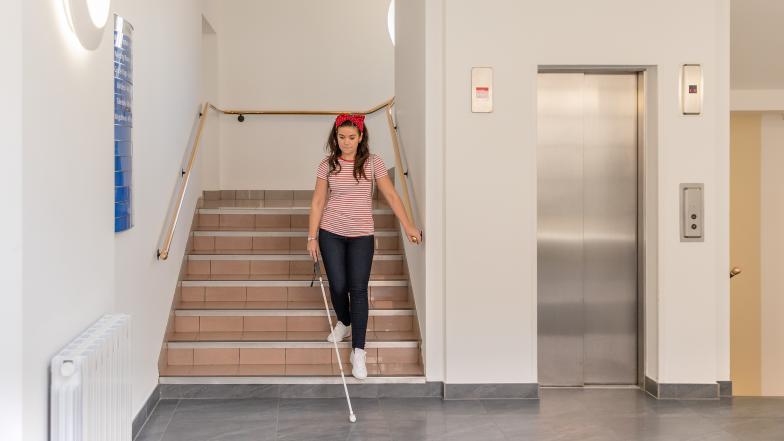Using your long cane to go up and down stairs or steps
The following checklist is a guide for existing cane users to navigating stairs or steps with your long cane. We have put together these tips to refresh, or be used alongside, the skills you have already learnt. If you are new to long cane training or would like to know more about the benefits, please contact your local authority’s sensory team before practising or using these techniques.
Using your long cane to go up and down stairs or steps
Going up stairs
- Use the cane tip to locate the bottom step, keep the cane tip in contact with the first step, then walk forward and place your foot on the first step.
- Pop up, and use your cane to scan from left to right to find a handrail. Use your free hand to hold onto it.
- You can use your long cane in either your left or right hand.
- When you have found the handrail swap your cane to the other hand if you need to.
- Once comfortable, lift your cane to locate the next step (first riser), and this will give you an indication of the height of each step.
- Extend your cane out straight in front of you. Your cane should reach approximately two steps up (two risers). Hold your cane under the handle in a pencil grip.
- In that position continue to move up the stairs. Your cane will swing forward to let you know when you have one step left.
- Before leaving the stairs and moving forwards, scan your cane from left to right to check your pathway.
Going down stairs or steps

- When you approach a set of stairs or steps, your cane will drop to indicate the first step down.
- Again, search for a handrail and hold onto it.
- Place your cane at your side, palm facing up and your cane placed lightly in your hand.
- Let your cane drop down two steps (two risers). Remember not to let your cane to protrude out to the side, and when you are ready start to walk down the stairs.
- When the cane slides away across the ground, this lets you know you have reached the bottom. Before stepping forwards away from the stairs scan your cane forward to check the pathway.
- Remember to always listen out for other people and keep your cane in your own personal space.
Related content
- Touch technique with your long cane
- Diagonal technique with your long cane
- Using your long cane to go up and down stairs or steps
- Protective techniques
- Trailing
- Travelling across open spaces
- What type of cane do I need?
- Learning the layout of a room
- Locating dropped items
- Systematic search patterns